Linlu Qiu
On the Same Wavelength? Evaluating Pragmatic Reasoning in Language Models across Broad Concepts
Sep 08, 2025Abstract:Language use is shaped by pragmatics -- i.e., reasoning about communicative goals and norms in context. As language models (LMs) are increasingly used as conversational agents, it becomes ever more important to understand their pragmatic reasoning abilities. We propose an evaluation framework derived from Wavelength, a popular communication game where a speaker and a listener communicate about a broad range of concepts in a granular manner. We study a range of LMs on both language comprehension and language production using direct and Chain-of-Thought (CoT) prompting, and further explore a Rational Speech Act (RSA) approach to incorporating Bayesian pragmatic reasoning into LM inference. We find that state-of-the-art LMs, but not smaller ones, achieve strong performance on language comprehension, obtaining similar-to-human accuracy and exhibiting high correlations with human judgments even without CoT prompting or RSA. On language production, CoT can outperform direct prompting, and using RSA provides significant improvements over both approaches. Our study helps identify the strengths and limitations in LMs' pragmatic reasoning abilities and demonstrates the potential for improving them with RSA, opening up future avenues for understanding conceptual representation, language understanding, and social reasoning in LMs and humans.
The Surprising Effectiveness of Test-Time Training for Abstract Reasoning
Nov 11, 2024
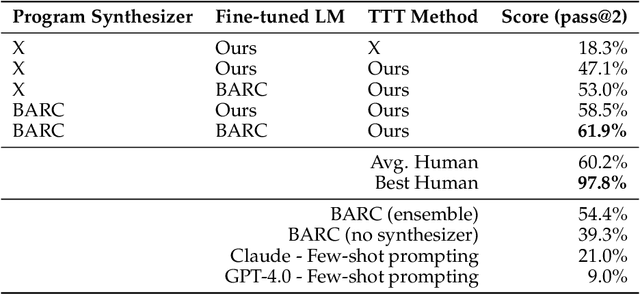
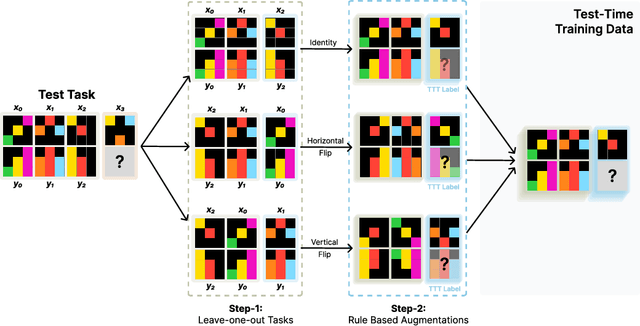
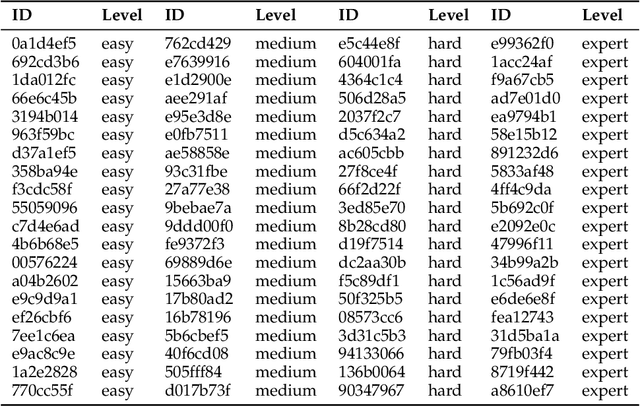
Abstract:Language models have shown impressive performance on tasks within their training distribution, but often struggle with novel problems requiring complex reasoning. We investigate the effectiveness of test-time training (TTT) -- updating model parameters temporarily during inference using a loss derived from input data -- as a mechanism for improving models' reasoning capabilities, using the Abstraction and Reasoning Corpus (ARC) as a benchmark. Through systematic experimentation, we identify three crucial components for successful TTT: (1) initial finetuning on similar tasks (2) auxiliary task format and augmentations (3) per-instance training. TTT significantly improves performance on ARC tasks, achieving up to 6x improvement in accuracy compared to base fine-tuned models; applying TTT to an 8B-parameter language model, we achieve 53% accuracy on the ARC's public validation set, improving the state-of-the-art by nearly 25% for public and purely neural approaches. By ensembling our method with recent program generation approaches, we get SoTA public validation accuracy of 61.9%, matching the average human score. Our findings suggest that explicit symbolic search is not the only path to improved abstract reasoning in neural language models; additional test-time applied to continued training on few-shot examples can also be extremely effective.
Lookback Lens: Detecting and Mitigating Contextual Hallucinations in Large Language Models Using Only Attention Maps
Jul 09, 2024Abstract:When asked to summarize articles or answer questions given a passage, large language models (LLMs) can hallucinate details and respond with unsubstantiated answers that are inaccurate with respect to the input context. This paper describes a simple approach for detecting such contextual hallucinations. We hypothesize that contextual hallucinations are related to the extent to which an LLM attends to information in the provided context versus its own generations. Based on this intuition, we propose a simple hallucination detection model whose input features are given by the ratio of attention weights on the context versus newly generated tokens (for each attention head). We find that a linear classifier based on these lookback ratio features is as effective as a richer detector that utilizes the entire hidden states of an LLM or a text-based entailment model. The lookback ratio-based detector -- Lookback Lens -- is found to transfer across tasks and even models, allowing a detector that is trained on a 7B model to be applied (without retraining) to a larger 13B model. We further apply this detector to mitigate contextual hallucinations, and find that a simple classifier-guided decoding approach is able to reduce the amount of hallucination, for example by 9.6% in the XSum summarization task.
Learning to Reason via Program Generation, Emulation, and Search
May 28, 2024Abstract:Program synthesis with language models (LMs) has unlocked a large set of reasoning abilities; code-tuned LMs have proven adept at generating programs that solve a wide variety of algorithmic symbolic manipulation tasks (e.g. word concatenation). However, not all reasoning tasks are easily expressible as code, e.g. tasks involving commonsense reasoning, moral decision-making, and sarcasm understanding. Our goal is to extend an LM's program synthesis skills to such tasks and evaluate the results via pseudo-programs, namely Python programs where some leaf function calls are left undefined. To that end, we propose, Code Generation and Emulated EXecution (CoGEX). CoGEX works by (1) training LMs to generate their own pseudo-programs, (2) teaching them to emulate their generated program's execution, including those leaf functions, allowing the LM's knowledge to fill in the execution gaps; and (3) using them to search over many programs to find an optimal one. To adapt the CoGEX model to a new task, we introduce a method for performing program search to find a single program whose pseudo-execution yields optimal performance when applied to all the instances of a given dataset. We show that our approach yields large improvements compared to standard in-context learning approaches on a battery of tasks, both algorithmic and soft reasoning. This result thus demonstrates that code synthesis can be applied to a much broader class of problems than previously considered. Our released dataset, fine-tuned models, and implementation can be found at \url{https://github.com/nweir127/CoGEX}.
Language Model Evolution: An Iterated Learning Perspective
Apr 04, 2024



Abstract:With the widespread adoption of Large Language Models (LLMs), the prevalence of iterative interactions among these models is anticipated to increase. Notably, recent advancements in multi-round self-improving methods allow LLMs to generate new examples for training subsequent models. At the same time, multi-agent LLM systems, involving automated interactions among agents, are also increasing in prominence. Thus, in both short and long terms, LLMs may actively engage in an evolutionary process. We draw parallels between the behavior of LLMs and the evolution of human culture, as the latter has been extensively studied by cognitive scientists for decades. Our approach involves leveraging Iterated Learning (IL), a Bayesian framework that elucidates how subtle biases are magnified during human cultural evolution, to explain some behaviors of LLMs. This paper outlines key characteristics of agents' behavior in the Bayesian-IL framework, including predictions that are supported by experimental verification with various LLMs. This theoretical framework could help to more effectively predict and guide the evolution of LLMs in desired directions.
Phenomenal Yet Puzzling: Testing Inductive Reasoning Capabilities of Language Models with Hypothesis Refinement
Oct 12, 2023Abstract:The ability to derive underlying principles from a handful of observations and then generalize to novel situations -- known as inductive reasoning -- is central to human intelligence. Prior work suggests that language models (LMs) often fall short on inductive reasoning, despite achieving impressive success on research benchmarks. In this work, we conduct a systematic study of the inductive reasoning capabilities of LMs through iterative hypothesis refinement, a technique that more closely mirrors the human inductive process than standard input-output prompting. Iterative hypothesis refinement employs a three-step process: proposing, selecting, and refining hypotheses in the form of textual rules. By examining the intermediate rules, we observe that LMs are phenomenal hypothesis proposers (i.e., generating candidate rules), and when coupled with a (task-specific) symbolic interpreter that is able to systematically filter the proposed set of rules, this hybrid approach achieves strong results across inductive reasoning benchmarks that require inducing causal relations, language-like instructions, and symbolic concepts. However, they also behave as puzzling inductive reasoners, showing notable performance gaps in rule induction (i.e., identifying plausible rules) and rule application (i.e., applying proposed rules to instances), suggesting that LMs are proposing hypotheses without being able to actually apply the rules. Through empirical and human analyses, we further reveal several discrepancies between the inductive reasoning processes of LMs and humans, shedding light on both the potentials and limitations of using LMs in inductive reasoning tasks.
Reasoning or Reciting? Exploring the Capabilities and Limitations of Language Models Through Counterfactual Tasks
Aug 01, 2023Abstract:The impressive performance of recent language models across a wide range of tasks suggests that they possess a degree of abstract reasoning skills. Are these skills general and transferable, or specialized to specific tasks seen during pretraining? To disentangle these effects, we propose an evaluation framework based on "counterfactual" task variants that deviate from the default assumptions underlying standard tasks. Across a suite of 11 tasks, we observe nontrivial performance on the counterfactual variants, but nevertheless find that performance substantially and consistently degrades compared to the default conditions. This suggests that while current LMs may possess abstract task-solving skills to a degree, they often also rely on narrow, non-transferable procedures for task-solving. These results motivate a more careful interpretation of language model performance that teases apart these aspects of behavior.
QDTrack: Quasi-Dense Similarity Learning for Appearance-Only Multiple Object Tracking
Oct 12, 2022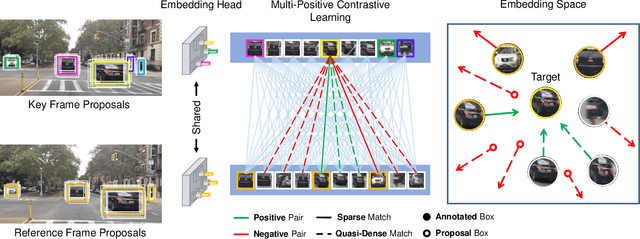

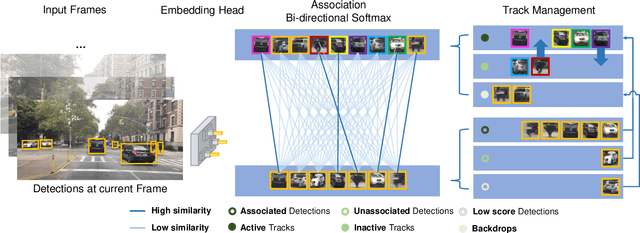
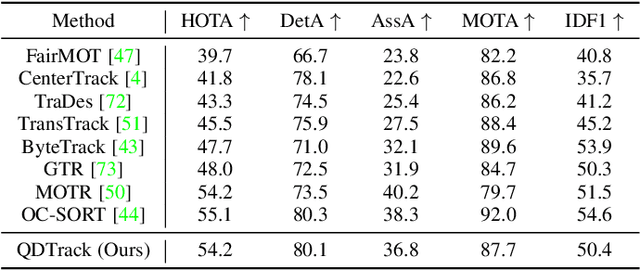
Abstract:Similarity learning has been recognized as a crucial step for object tracking. However, existing multiple object tracking methods only use sparse ground truth matching as the training objective, while ignoring the majority of the informative regions in images. In this paper, we present Quasi-Dense Similarity Learning, which densely samples hundreds of object regions on a pair of images for contrastive learning. We combine this similarity learning with multiple existing object detectors to build Quasi-Dense Tracking (QDTrack), which does not require displacement regression or motion priors. We find that the resulting distinctive feature space admits a simple nearest neighbor search at inference time for object association. In addition, we show that our similarity learning scheme is not limited to video data, but can learn effective instance similarity even from static input, enabling a competitive tracking performance without training on videos or using tracking supervision. We conduct extensive experiments on a wide variety of popular MOT benchmarks. We find that, despite its simplicity, QDTrack rivals the performance of state-of-the-art tracking methods on all benchmarks and sets a new state-of-the-art on the large-scale BDD100K MOT benchmark, while introducing negligible computational overhead to the detector.
Generate-and-Retrieve: use your predictions to improve retrieval for semantic parsing
Sep 29, 2022



Abstract:A common recent approach to semantic parsing augments sequence-to-sequence models by retrieving and appending a set of training samples, called exemplars. The effectiveness of this recipe is limited by the ability to retrieve informative exemplars that help produce the correct parse, which is especially challenging in low-resource settings. Existing retrieval is commonly based on similarity of query and exemplar inputs. We propose GandR, a retrieval procedure that retrieves exemplars for which outputs are also similar. GandRfirst generates a preliminary prediction with input-based retrieval. Then, it retrieves exemplars with outputs similar to the preliminary prediction which are used to generate a final prediction. GandR sets the state of the art on multiple low-resource semantic parsing tasks.
Evaluating the Impact of Model Scale for Compositional Generalization in Semantic Parsing
May 24, 2022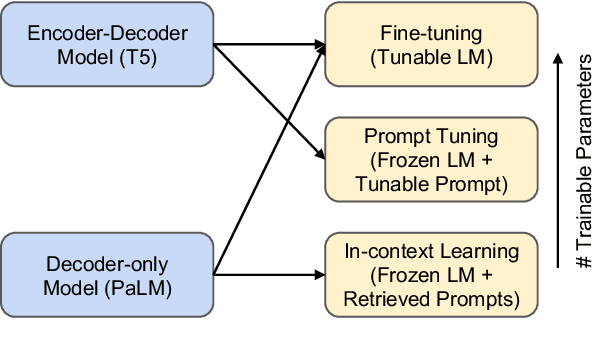

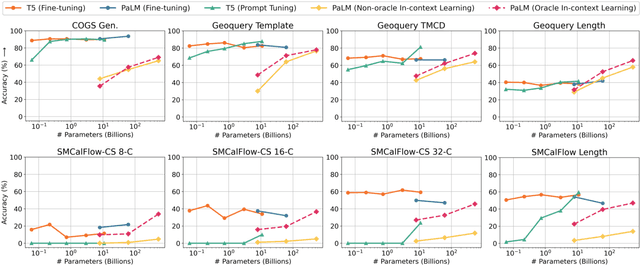

Abstract:Despite their strong performance on many tasks, pre-trained language models have been shown to struggle on out-of-distribution compositional generalization. Meanwhile, recent work has shown considerable improvements on many NLP tasks from model scaling. Can scaling up model size also improve compositional generalization in semantic parsing? We evaluate encoder-decoder models up to 11B parameters and decoder-only models up to 540B parameters, and compare model scaling curves for three different methods for transfer learning: fine-tuning all parameters, prompt tuning, and in-context learning. We observe that fine-tuning generally has flat or negative scaling curves on out-of-distribution compositional generalization in semantic parsing evaluations. In-context learning has positive scaling curves, but is generally outperformed by much smaller fine-tuned models. Prompt-tuning can outperform fine-tuning, suggesting further potential improvements from scaling as it exhibits a more positive scaling curve. Additionally, we identify several error trends that vary with model scale. For example, larger models are generally better at modeling the syntax of the output space, but are also more prone to certain types of overfitting. Overall, our study highlights limitations of current techniques for effectively leveraging model scale for compositional generalization, while our analysis also suggests promising directions for future work.
 Add to Chrome
Add to Chrome Add to Firefox
Add to Firefox Add to Edge
Add to Edge